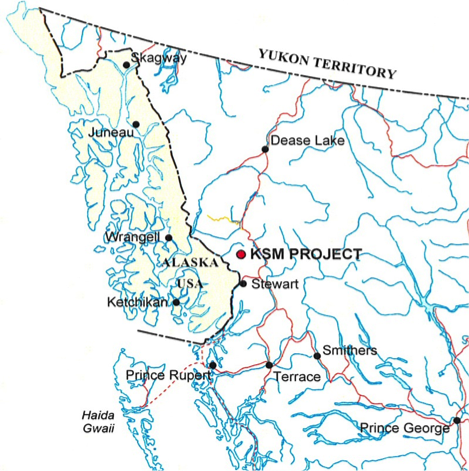We’ve heard a lot about mines planned for northwest British Columbia, just across Alaska’s border.
Southeast tribal, fishing and environmental groups have blasted those plans. Critics say they’ll pollute rivers that cross the border, damaging or destroying salmon and other fish runs.
But we haven’t heard a lot from mine advocates. Now, we have.

Much of the recent focus has been on what’s called the Kerr-Sulphurets-Mitchell or KSM Project, being developed by Seabridge Gold.
The site, which also includes copper, is roughly 80 miles east of Wrangell.
Critics say it could damage the Unuk River, which flows into the ocean northeast of Ketchikan.
Seabridge says that’s not the case. Brent Murphy is the corporation’s vice president of environmental affairs
“The concern with minimizing downstream environmental impacts has been the guiding principal behind the whole design of the mining project,” Murphy says.
Critics say the KSM could be about the same size as the proposed Pebble Prospect, a controversial mine proposed for Southwest Alaska.
They worry about plans for huge, dammed tailing lakes that could leak or break, sending acidic water into nearby streams and rivers.
Murphy says they’ll be built in a valley that drains into Canadian, not Alaskan, waters.
“The dams will be of a design which has been utilized worldwide. And these dams are extremely stable over the long term,” he says.
And what is the estimated life of those dams?
“They have to last for the 52 years of operations. And then we will reclaim that and they will last into perpetuity.”
Seabridge Gold has been working on the project since 2008. Murphy says even if everything goes its way, operations won’t begin until the 2020.
“You don’t build a mine overnight,” says Karina Brino, president of the Mining Association of British Columbia.
“There are a series of authorizations and permits from different levels of government that are required. And other than the Red Chris Mine, in the northwest, all the other projects are in exploration stages,” she says.
The Red Chris Mine is in the upper watershed of the Stikine River, which ends near Petersburg and Wrangell. It’s owned by Imperial Metals.
Another project of concern is the long-closed Tulsequah Chief Mine, which Chieftain Metals Corp is trying to reopen. It’s on a tributary of the Taku River, which ends near Juneau.
Critics, including the group Rivers Without Borders, are concerned about silt, acid discharge and dangerous metals.
The Mining Association’s Brino says the same is true for her industry.
“Our objective is to minimize impact. Our objective is to be stewards of the environment as much as anybody else would want us to be,” she says.
So, does the industry care about concerns from this side of the border?
“Absolutely,” Brino says. “My expectation would be that there is participation, hopefully meaningful participation, from your side of the border in the review of these projects.”
Seabridge Gold official Murphy says his company has consulted with Alaska officials once or twice a year since the project began. They’ve also been brought to the KSM mine site.
He says the project needs about 150 permits from the provincial and federal governments.
“We will have to do a lot of work in order to gather the information that will be needed to satisfy the … questions from our regulatory authorities,” Murphy says.
Seabridge just began a season of exploratory drilling at the site. That will help better define where the minerals are, and how much may be there.
